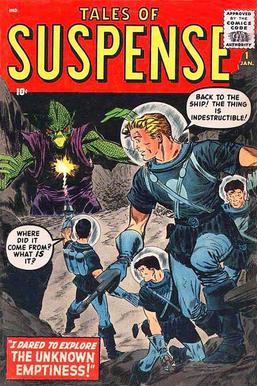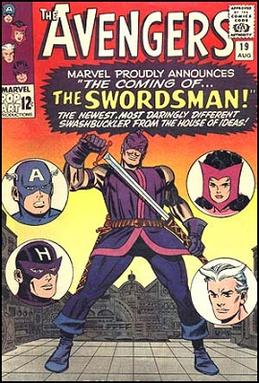
Captain America is a superhero created by Joe Simon and Jack Kirby who appears in American comic books published by Marvel Comics. The character first appeared in Captain America Comics #1, published on December 20, 1940, by Timely Comics, a corporate predecessor to Marvel. Captain America's civilian identity is Steve Rogers, a frail man enhanced to the peak of human physical perfection by an experimental "super-soldier serum" after joining the United States Army to aid the country's efforts in World War II. Equipped with an American flag-inspired costume and a virtually indestructible shield, Captain America and his sidekick Bucky Barnes clashed frequently with the villainous Red Skull and other members of the Axis powers. In the final days of the war, an accident left Captain America frozen in a state of suspended animation until he was revived in modern times. He resumes his exploits as a costumed hero and becomes leader of the superhero team the Avengers, but frequently struggles as a "man out of time" to adjust to the new era.

Tales of Suspense is the name of an American comic book anthology series, and two one-shot comics, all published by Marvel Comics. The first, which ran from 1959 to 1968, began as a science-fiction anthology that served as a showcase for such artists as Jack Kirby, Steve Ditko, and Don Heck, then featured superheroes Captain America and Iron Man during the Silver Age of Comic Books before changing its title to Captain America with issue #100. Its sister title was Tales to Astonish. Following the launch of Marvel Legacy in 2017, Tales of Suspense was once again resurrected at issue #100, featuring the Winter Soldier and Hawkeye in a story called "The Red Ledger".

Miss America is a superhero appearing in American comic books published by Marvel Comics. Created by writer Otto Binder and artist Al Gabriele, the character first appeared in Marvel Mystery Comics #49 in the Golden Age of Comic Books. Madeline Joyce is the first incarnation of Miss America. The character has also been a member of the Invaders, Liberty Legion, and All-Winners Squad at various points in her history.

All Select Comics is a 1943–1945 American comic book series published by Timely Comics, the 1940s predecessor of Marvel Comics, during the period fans and historians call the Golden Age of comic books. An omnibus series with several different superhero and other features each issue, it primarily starred Captain America and the original Human Torch, two of Timely's most popular characters, as well as fellow Timely star the Sub-Mariner in several.

Spy Smasher is the name of two fictional characters appearing in comics published by Fawcett and DC Comics. The first is a superhero that was formerly owned and published by Fawcett Comics. The second is a female anti-terrorism government agent and enemy of the Birds of Prey.

Swordsman is a character appearing in American comic books published by Marvel Comics. Created by Stan Lee and Don Heck, the character first appeared in The Avengers #19. Although Swordsman was first introduced as an enemy of Hawkeye and the Avengers, the character has since appeared as both a supervillain and a superhero.
Carl Burgos was an American comic book and advertising artist best known for creating the original Human Torch in Marvel Comics #1, during the period historians and fans call the Golden Age of comic books.

Daredevil is a fictional superhero created by Jack Binder, who starred in comics from Lev Gleason Publications during the 1930s–1940s period historians and fans call the Golden Age of comic books before being retroactively established into the Image Universe by Image Comics in the 1990s as its first character. The character is unrelated to Marvel Comics' Daredevil, and recent renditions of the character have often renamed him to avoid confusion and potential lawsuits.

The Blazing Skull is a fictional character appearing in American comic books published by Marvel Comics. The character was created during the Golden Age of Comic Books by Marvel's predecessor, Timely Comics, and first appeared in Mystic Comics #5. The character's writer and artist creators are unknown. The Blazing Skull fell into obscurity after the 1940s, and was revived in the 1990s.
Phantom Eagle is the name used by two fictional aviator heroes appearing in American comic books.

The Blonde Phantom is a fictional masked crime fighter appearing in American comic books published by Marvel Comics. Created for Marvel predecessor Timely Comics by Stan Lee and Syd Shores, the character first appeared in All Select Comics #11, during the 1940s period fans and historians call the Golden Age of Comic Books. The heroine was so well received that the next issue was retitled The Blonde Phantom. The series continued to feature her until issue #22. She also appeared in backup stories in many other Timely comics; in Superhero Comics of the Golden Age, Mike Benton observes that "for a few months in 1948, readers could find her in seven titles on the newsstand." In The Supergirls, Mike Madrid asserted, "Once again, a capable woman hid behind a meek persona and only let her hair down, literally, to come to the aid of a man who completely ignored her unless she assumed a disguise. In a 1947 story entitled "I Hate Myself", Louise even dreams that Mark finally confesses his love for her, only to have the Blonde Phantom persona appear and steal him away."

Betsy Ross is a character appearing in American comic books published by Marvel Comics. Created by Joe Simon and Jack Kirby, the character first appeared in Captain America Comics #1. Betsy Ross is Captain America's early love interest and supporting character in American comic books published by Marvel Comics during the 1930-1940s period known to historians and collectors as the Golden Age of Comic Books. She then debuted as the superheroine Golden Girl in Captain America Comics #66.

The Black Marvel is a fictional superhero appearing in American comic books published by Marvel Comics. Created by artist Al Gabriele with an unknown writer, he first appeared in Mystic Comics #5, published by Marvel's 1930s forerunner Timely Comics during the period fans and historians call the Golden Age of Comic Books.

Jack Frost is a fictional superhero appearing in American comic books published by Marvel Comics. The character first appeared in 1941 in U.S.A. Comics published by Marvel's 1940s forerunner Timely Comics, during the period fans and historians call the Golden Age of comic books.

Daring Mystery Comics is an American comic-book series published by Timely Comics, a predecessor of Marvel Comics, during the 1930-1940s period fans and historians call the Golden Age of Comic Books. Primarily a superhero anthology, it ran eight issues from 1940 to 1942, and is notable for work by Carl Burgos, Bill Everett, Alex Schomburg, and the team of Joe Simon & Jack Kirby.

Rockman is a fictional superhero appearing in American comic books published by Marvel Comics. The character first appeared in U.S.A. Comics No. 1, published by Marvel predecessor Timely Comics during the 1930s to 1940s period historians and fans call the Golden Age of Comics. As credits were not routinely given in comic books of this period, his writer and artist co-creators are unknown, although the first page of his debut story was drawn by Charles Nicholas and the remainder by Basil Wolverton.

Hawkeye is a fictional character appearing in American comic books published by Marvel Comics. Created by writer Stan Lee and artist Don Heck, the character first appeared as a supervillain in Tales of Suspense #57 and later joined the Avengers as a superhero in The Avengers #16. He has since been a prominent member of several Avengers teams, founding the West Coast Avengers, briefly marrying and subsequently divorcing Bobbi Morse / Mockingbird, adopting the Ronin alias after his death and resurrection before mentoring Kate Bishop as his successor as Hawkeye. He was also ranked at #44 on IGN's Top 100 Comic Book Heroes list.

The Destroyer is the name of three fictional superheroes appearing in American comic books published by Marvel Comics. The original incarnation was created by writer Stan Lee and artist Jack Binder and first appeared in Mystic Comics #6, being one of Lee's earliest creations during the Golden Age of Comic Books.
















